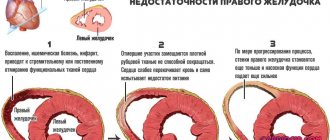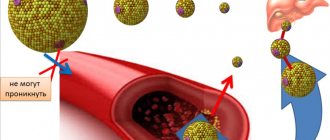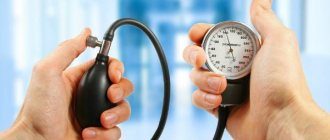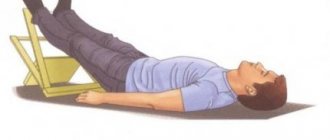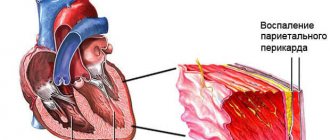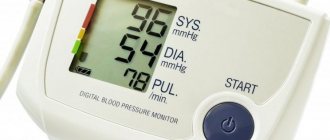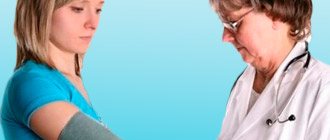Relationship between heart rate and blood pressure
Blood vessels at low (hypotension) and normal pressure are not compressed. Therefore, low blood pressure and low heart rate are not interrelated.
The pulse rate is determined by signals from receptors located in the heart and, partially, in the brain. As a rule, they do not affect blood pressure, the increase in which is associated with completely different reasons.
High blood pressure is associated with compression of blood vessels. This compression causes the heart rate to decrease. Therefore, a low pulse is characteristic of hypertension (high blood pressure). But this rule does not always work.
If intracranial pressure increases, it affects the vagus nerve, which lowers the heart rate. The difference between mean arterial pressure (BP) and intracranial pressure is called cerebral pressure.
A low pulse with high blood pressure is most often associated with possible concomitant diseases, for example, the thyroid gland.
Tonometer readings: low pulse with high blood pressure
Causes of pathology
The adaptive-compensatory properties of the body are designed to ensure that an increase in blood pressure is simultaneously accompanied by an increase in vascular pulsation. The multidirectional nature of these processes indicates malfunctions in the functioning of the circulatory system. Triggers of vascular imbalance are divided into physiological and pathological.
Physiological
In hypertensive patients, due to structural changes in the vascular wall, an increase in pressure against the background of a decrease in pulse is considered a physiological norm. There are no interruptions, heart rate (heart rate) is 60-55/minute, the general condition is satisfactory.
In addition, physiological bradycardia against the background of hypertension occurs:
- in athletes;
- at night time;
- in cold climates;
- when hypertensive patients take medications that reduce vascular pulsation;
- pressing on the eyeballs - Aschner's syndrome or vagal correction of heart rate (also used in diagnosing pathology).
Eliminating the causes straightens the situation.
Pathological
They are heterogeneous, form a large group, but the heart rate is less than 55, the pulse can be rhythmic or arrhythmic, the pressure exceeds 140/90. This category includes:
- failure of the sinus node, which generates cardiac impulses;
- cardiosclerosis, when the replacement of muscle cells with connective tissue leads to destruction of the valvular apparatus of the heart, a decrease in myocardial contractility;
- VSD, arrhythmia;
- congenital defects, hereditary cardiopathology;
- post-infarction state;
- infectious and inflammatory processes of the myocardium leading to cardiosclerosis;
- complications of ARVI, influenza that impair the contractile function of the heart;
- vitamin deficiency, fasting, including therapeutic fasting, which provokes a lack of myocardial nutrition, changes in metabolism, impaired vascular permeability;
- metabolic imbalance with obesity, development of atherosclerosis, destruction of the vascular endothelium;
- stress, neuroses with disorders of neuroregulation of the vascular bed;
- endocrine pathologies (hypothyroidism);
- internal bleeding: Crohn's disease, stomach ulcer, duodenal ulcer, other erosive processes in the intestines that cause anemia;
- meningitis;
- physical hyperstress against the background of long-existing somatic diseases.
Causes of high blood pressure and low pulse
A pulse rate of less than 60 beats per minute is considered low. If the pulse drops to 50 beats/min, this condition is called bradycardia and requires immediate medical intervention. Possible phenomena with bradycardia may be:
- loss of consciousness;
- heart attack;
- stroke;
- pulmonary edema;
- slow heartbeat.
In the most severe cases, coma and even death of the patient is possible.
To establish the causes of low pulse with high blood pressure, you need to undergo a medical examination. This condition may be associated with the following factors:
- a sharp increase in cerebral pressure (see above);
- disruption of blood circulation and dynamics in the brain, which can lead to stroke;
- heart and valve defects;
- heart attack;
- changes in hormonal levels;
- taking medications;
- hypothermia;
- allergies;
- sclerosis of the heart vessels.
Often a decrease in heart rate is caused by hypothyroidism, a disease associated with a low concentration of thyroid hormones in the blood.
Increased blood pressure may be a consequence of a neurotic personality, when a person reacts too emotionally to various external circumstances. This reaction is typical for young emotionally unstable women. In such cases, consultation with a neurologist and psychiatrist is required.
Pulse rates vary depending on a person's age
Reasons for decreased heart rate and increased blood pressure
The reasons that contribute to increased blood pressure and decreased heart rate in humans are:
- hypertonic disease;
- vegetative-vascular dystonia;
- intracardiac blockade;
- malfunction of the sinus node;
- hormonal imbalance;
- uncontrolled physical activity;
- a disorder of the nervous system, such as a stroke.
All of the above reasons for increased blood pressure and decreased heart rate can be either regular or temporary. Also, a condition in which blood pressure increases and heart rate decreases can occur when there is a difference in atmospheric pressure and a change in the ambient temperature. Hypertensive patients – people with high blood pressure – feel this especially sensitively.
Diagnostics
An accurate diagnosis can only be made after a complete medical examination. It is necessary to carefully examine the condition of the heart and blood vessels. During the examination, you must undergo an examination by a therapist or cardiologist, take an electrocardiogram, do an ultrasound of the heart and monitoring with a Holter sensor (24-hour ECG recording with periodic blood pressure measurements).
The list of necessary medical diagnostic procedures also includes studying the conductivity of cardiac tissue using a special sensor, determining the concentration of thyroid hormones and determining the neuropsychiatric status of the patient.
Additionally, the doctor may prescribe general and biochemical blood and urine tests, hormone tests, X-ray and ultrasound examinations and other studies.
Traditional recipes at home
A large number of people attribute this ailment to a temporary imbalance. But this can be done if the increase in pressure and decrease in pulse occurred once. But if this happens regularly, then you need to seek medical help.
If high blood pressure and low heart rate occur due to hypothermia or due to chronic fatigue, then this condition may go away on its own. It is enough to drink hot tea, wrap yourself in a warm blanket and give your body a few days to rest. But if an increased pulse with high blood pressure is associated with improper functioning of the cardiovascular system, then in this case you cannot do without the help of a cardiologist.
What folk remedies can help with high blood pressure and low heart rate at home? Not all remedies can help in this situation, since you can raise your heart rate by doing physical exercise for five minutes. But sports are not always indicated for high blood pressure, because the load can increase the pressure even more.
To lower blood pressure and increase heart rate, the following traditional tincture recipes can help:
- Radish juice with honey. Grate a small radish and squeeze out the juice. Pour into a glass and add 2 tbsp. liquid honey. Stir and let sit for 2 hours. Take 1 tsp. with high blood pressure and low pulse.
- Lemon juice with walnuts. Grind 2 tbsp in a blender. peeled walnuts, transfer to a glass. Add 1 tsp there. sesame oil, 1 tsp. sugar and 2 tsp. lemon juice. Stir. Let it brew for a day and take 1 tsp.
- Motherwort infusion. You can buy dry motherwort herb at the pharmacy, brew it according to the instructions and take it to lower blood pressure and increase heart rate.
- Pine tincture with alcohol. 2 tbsp. pour 200 grams of pine needles. vodka and let it brew for a day. Take 1 tbsp. 2 times a day for high blood pressure and low pulse.
- Wine with honey. In addition to the above-mentioned folk recipes for tinctures, wine boiled with honey helps in such cases. Boil a glass of wine with 1 tbsp. honey Let cool and take 2 tbsp.
What to do - first aid
Correctly provided first aid in emergency cases can save a patient's life.
If your pulse drops below 35 beats/min, you should urgently call an ambulance. Before her arrival, the patient should be placed on his back, with small pillows under his feet and head. Self-treatment of such a patient can be life-threatening.
A rare but extremely dangerous complication of low heart rate and high blood pressure is cardiac arrest. If urgent resuscitation measures are not started, the person will die. If the patient has lost consciousness, cardiac massage and artificial respiration should be started. Before performing artificial respiration, you need to use gauze or a handkerchief to free the oral cavity from any foreign bodies.
If the victim's pulse cannot be felt, cardiopulmonary resuscitation must be started.
If the person is conscious, you need to give him medications that can increase the pulse. In addition, you can give 20-30 drops of ginseng or hawthorn tincture, 30 drops of Corvalol, or put a nitroglycerin tablet under the tongue.
If the patient's condition is satisfactory, you need to cover him with a warm blanket.
If emergency doctors offer hospitalization, it is better not to refuse. Also, do not hesitate to consult a doctor if any incomprehensible and unpleasant symptoms associated with the activity of the heart appear: dizziness, constant weakness, drowsiness, attacks of pain (not necessarily in the heart area), especially associated with physical activity, the occurrence of an unreasonable feeling of fear and panic attacks . This is especially important in the presence of concomitant endocrine diseases.
Symptoms that require seeing a doctor or calling an ambulance
The list of life- and health-threatening symptoms is quite wide. It is necessary to consult a doctor in any unclear situation; there is no need to be embarrassed about it. False installations can be very expensive.
Among the manifestations that should alert you are:
- Headache of any location and degree of intensity. This is a dangerous manifestation. Indicates a violation of vascular tone and blood circulation.
- Dizziness. Especially of a regular nature. Associated with an attack of bradycardia and arterial hypertension.
- Impaired consciousness. Confusion, inability to think normally. It is dangerous because it indicates an acute cerebrovascular accident.
- Chest pain. They give it to the back and hands.
- Shortness of breath, breathing problems.
- Feeling of unreasonable fear, panic attack.
- Pulse less than 50 beats per minute, weakness, drowsiness, fatigue and a significant decrease in performance even in the morning.
What not to do
Periodic attacks and constant low pulse with high blood pressure require treatment under the supervision of a physician.
It is also necessary to change your lifestyle: do not overcool, do not smoke or drink alcohol, and eliminate stressful conditions. Constant sedentary work also contributes to the occurrence of attacks.
During attacks, you need to put the patient on his back. Do not strain, exercise, drink caffeine-containing drinks, including coffee or tea, or make sudden movements. You should not take medications such as magnesium sulfate, Citramon, or medications that lower blood pressure.
Under no circumstances should you drink tonic drinks or take sedatives. They can only worsen bradycardia.
Daily walks in the fresh air improve the functioning of the cardiovascular system
What are the symptoms for this condition?
The first thing that happens in this case is a disruption of the general blood circulation in the body. Since the vessels are not able to provide adequate transport of nutrients and oxygen, vital functions begin to suffer.
What happens in the body:
- Sharp spasm of blood vessels;
- Poor contractility of the heart;
- Hypoxic phenomena in tissues and organs.
The combination of low heart rate and high blood pressure can pose a double threat to your health. Indeed, against the background of all the changes in the body, the nutrition of the myocardium is significantly deteriorating. In turn, this significantly increases the risk of heart attack and stroke.
Minor and infrequent fluctuations do not pose a threat to health. In such a situation, the human body, being in homeostasis, is still able to adapt to changes in time. At the same time, about 20% of people do not change their daily rhythm of life and can continue working.
Possible side symptoms:
- Vomiting and nausea;
- Dizziness;
- Muscle spasms;
- Chest pain;
- Attacks of suffocation;
- Convulsive twitching;
- Sharp weakness.
Don't forget about such an important factor as stress. With regular emotional stress, all these symptoms can intensify and your state of health worsens sharply.
Therapeutic treatment
It is impossible to relieve high blood pressure and low pulse on your own. All medications should be taken only as prescribed by a doctor.
Your doctor may prescribe the following medications to lower your blood pressure:
- angiotensin-converting enzyme inhibitors (ACEIs);
- diuretics;
- calcium channel blockers.
During a heart attack and for 6 months after, bradycardia with mild hypertension is considered an acceptable condition. A heart attack is accompanied by the death of heart muscle tissue due to insufficient oxygen supply. The consequences of this cannot be completely eliminated; the patient must be under the medical supervision of the attending physician.
A similar situation can also occur in professional athletes under high physical exertion. Due to the body's habit of working under constant overload, they also often develop cardiovascular diseases after leaving sports.
A pacemaker may be recommended to restore heart rhythm. This is a device that is inserted (implanted) under the skin under local anesthesia. The pacemaker leads connect to the heart. The number of electrodes can be from one to three.
The pacemaker can operate in 2 modes:
- responds to rhythm disturbances;
- sends pulses at a fixed frequency.
The pacemaker is powered by a lithium battery with a service life of up to 15 years.
When choosing a treatment method, the doctor takes into account the patient’s age, the cause of the disease, the general condition of the heart and blood vessels, the level of cholesterol in the blood, and the presence of other diseases.
Installation of a pacemaker is one of the therapeutic measures for patients with cardiovascular diseases
Possible danger
It is worth noting that high blood pressure with a pulse below 60 beats, without obvious signs and deterioration of the condition, does not cause any danger, but treatment must be carried out. But if the pulsation is reduced to 40 beats, there is a high probability of oxygen deficiency; in medicine this condition is called hypoxia. The first thing that gets affected is the brain; irreversible changes begin in it.
The described condition is especially dangerous in old age. As a result of the problem, a heart attack, stroke, or cardiac arrest occurs. Often the problem ends in death.
With a sharp decrease in pulse, patients may lose consciousness and it is important to immediately call for medical help; without it, the person will simply die. Before the doctor's visit, you can perform artificial respiration, as well as apply heat to your feet and calves.
High blood pressure and low pulse cause the following consequences:
- As a result of pressure, spasms of blood vessels occur, their lumen narrows.
- A low heart rate makes blood flow slow.
- The whole body suffers and cannot function normally because there is not enough blood to function.
It is important to pay attention to your personal condition, constantly measure your pulse and blood pressure. If the device indicates values of 140/90 mmHg. Art. and higher, while the pulse is below 50 beats, then you need to urgently contact doctors for assistance.
Forecast
The most dangerous is the combination of severe hypertension (blood pressure above 140/90) and bradycardia (low heart rate - less than 60 beats/min). Fortunately, this condition is extremely rare. In this case, medical supervision of the patient is necessary, preferably in a hospital setting. It would be better if it was a specialized cardiology hospital.
Modern medicine can effectively correct this condition – low pulse combined with high blood pressure. The main thing is not to self-medicate and consult a doctor in time.
Prescribed examinations
If such symptoms are present, the patient should visit a cardiologist. He will order an examination to determine the cause of the violations, which will include:
- Electrocardiograms. A dosed load can be used to assess heart function.
- Holter ECG monitoring.
- Blood pressure screening.
Also read: How does atmospheric pressure affect hypertensive and hypotensive patients?
These are the main diagnostic measures that will provide detailed information about the functioning of the heart.
How to treat this disease
To reduce blood pressure and normalize the pulse, it is recommended to carry out medical therapy. Before doing anything to increase the heart rate, you need to become more familiar with the features of treating the pathology.
First aid
If there is a sharp deterioration in the heartbeat, first aid must be provided in order to quickly eliminate the symptoms of a low pulse and normalize blood pressure. To do this, the patient is placed on his back and a cold compress is placed on the lower back. Breathing therapy will help improve the patient's well-being. It not only normalizes breathing, but also calms the patient. It is also recommended to take vasodilators to improve blood circulation.
Medications
When treating pathology, doctors advise using medications that can normalize blood circulation and heartbeat.
Effective medications include:
- "Anaprilin." The drug is used to eliminate hypertension and its complications. Before using the medicine, it is better to consult a doctor, since Anaprilin is not suitable for all people with bradycardia.
- "Valoserdin." The drug is used to eliminate hypertension at an early stage of development. It is recommended to drink Valoserdin for no longer than a week, since long-term use of the drug causes bromine poisoning and addiction.
- "Concor". Many experts advise using this medicine to cope with heart failure and hypertension. Drink no more than 10 mg of the drug daily, since an overdose causes insomnia, convulsions and dizziness.
Folk remedies
Medicines do not always help stabilize the pulse and cope with hypertension. Therefore, some people use folk remedies instead of medications. Effective folk remedies include:
- Radish juice. To obtain juice, a small hole is cut in the vegetable, into which a spoonful of sugar and honey is poured. Then the radish is infused for an hour and a half, after which you can use the prepared infusion.
- Walnuts. To prepare a medicine from walnuts, you need to mix 400 grams of peeled nuts with 80 grams of sugar and 200 ml of sesame oil. Then the mixture is poured with hot water and lemon juice is added to it. The prepared liquid is poured into a separate container and infused for 12 hours.
